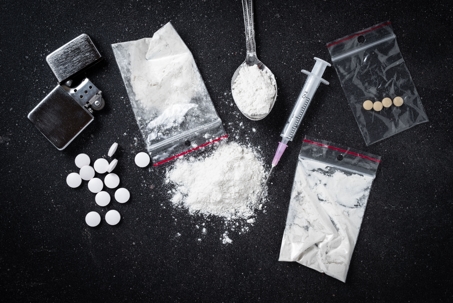New York Drug Possession Penalties
Drug crimes are among the highest criminal priorities for governments at the city, state and federal levels. For instance, the highest number of arrests in 2018 were for drug abuse violations, which concern the unlawful possession, sale, use, growing, manufacturing, and making of narcotic drugs including opium or cocaine and their derivatives, marijuana, synthetic narcotics, and dangerous nonnarcotic drugs such as barbiturates, according to the Bureau of Justice Statistics.
A potential reason for the high arrest rate is that law enforcement officials stop at nothing to ensure they are detecting and investigating drug crimes in their respective jurisdictions. Unfortunately, for people who are caught in the wrong place at the wrong time and especially with the wrong people, encountering the police will often result in drug charges. While criminal accusations of any kind are frightening, it’s worth remembering that charges do not indicate convictions. In other words, you are innocent until proven guilty. However, if you are found guilty of any drug crime in New York, the criminal penalties can be unforgiving.
With this in mind, our Bronx drug crime lawyer will explain the legal repercussions of certain drug crime convictions in New York. The information below is not comprehensive of all drug crimes and their punishments. Should you have any questions, please contact us at (646) 759-9233!
Federal Drug Schedules
The Drug Enforcement Administration handles controlled substance laws and regulations in the US. Before we discuss the drug crime penalties in New York, it is vital to learn how the DEA classifies controlled substances. Drugs, substances and certain chemicals used to make drugs are categorized into five schedules as such:
- Schedule I: Drugs with no currently accepted medical use and a high potential for abuse. Examples include heroin, LSD, marijuana, ecstasy, methaqualone and peyote.
- Schedule II: Drugs that are deemed dangerous and have a high potential for abuse, with use potentially leading to severe psychological or physical dependence. Examples of Schedule II drugs are Vicodin, cocaine, methamphetamine, methadone, OxyContin, fentanyl, Dexedrine, Adderall and Ritalin
- Schedule III: Drugs with a moderate to low potential for physical and psychological dependence. Schedule III drugs include products with less than 90 milligrams of codeine per dosage unit, ketamine, anabolic steroids and testosterone.
- Schedule IV: Drugs with a low potential for abuse and low risk of dependence. Xanax, Soma, Darvon, Valium, Ambien and Tramadol are examples.
- Schedule V: Drugs with lower potential for abuse than Schedule IV and consist of preparations containing limited quantities of certain narcotics. They are generally used for antidiarrheal, antitussive, and analgesic purposes, with examples including Robitussin AC, Lyrica and Parepectolin.
Drug Possession Crimes
Drug possession is of the most widely-committed drug offenses in the US. In summary, you could suffer life-altering felony charges that carry years behind bars and thousands of dollars in fines. An attorney could alleviate your sentence by negotiating for reduced or dismissed penalties but if they’re unsuccessful, you could be looking at the following punishments upon conviction:
Possessing a controlled substance: Class A misdemeanor punishable by up to 1 year in prison and/or $1,000 fines.
Possessing the following preparations and substances is a Class D felony punishable by 1 to 2.5 years in person and/or $5,000 fines:
- a controlled substance with intent to sell
- at least ½ oz preparations containing narcotics preparations
- at least ¼ oz concentrated cannabis preparation
- at least 500 mg cocaine
- at least 1,000 mg ketamine
- at least 28 g of gamma hydroxybutyric acid (GHB)
You may suffer a Class C felony punishable by 1 to 5.5 years in prison and/or up to $15,000 fines if you possess at least:
- ⅛ oz preparations containing a narcotic drug
- 2 oz preparations containing narcotics preparations
- 1 mg lysergic acid diethylamide (LSD)
- 25 mg hallucinogen
- 10 oz dangerous depressant
The conduct below is a Class B felony punishable by 1 to 9 years in prison and/or $30,000 fines:
- a narcotic with intent to sell
- a stimulant, hallucinogen, hallucinogenic substance, or LSD with intent to sell and a prior drug conviction
- at least 1 g stimulant with intent to sell
- at least 1 mg LSD with intent to sell
- at least 25 mg hallucinogen with intent to sell
- at least 5 mg LSD
While marijuana is increasingly becoming an accepted controlled substance in the US, there are limits. If you got in trouble for possessing preparations weighing more than 25 grams, or possessing 2 ounces or 8 ounces of marijuana, you may be subject to the following punishments, respectively:
- Class B misdemeanor charge publishable by up to 3 months in prison and/or up to $500 fines
- Class A misdemeanor charge punishable by up to 1 year in prison and/or up to $1,000 fines
- Class E felony charge punishable by 1 to 1.5 years in prison and/or up to $5,000 fines
Are You Facing Drug Possession Charges?
Our Bronx drug crime attorney at The Law Offices of Elliot S. Kay understands what you’re up against. The criminal justice system can be frightening and overwhelming, which doesn’t help when you’re fighting for your future and freedom. As such, we urge you to entrust your case with a lawyer who genuinely cares about your future and getting you back on track.
To learn more about how our Bronx drug crime lawyer can assist you, please contact our firm at (646) 759-9233!

